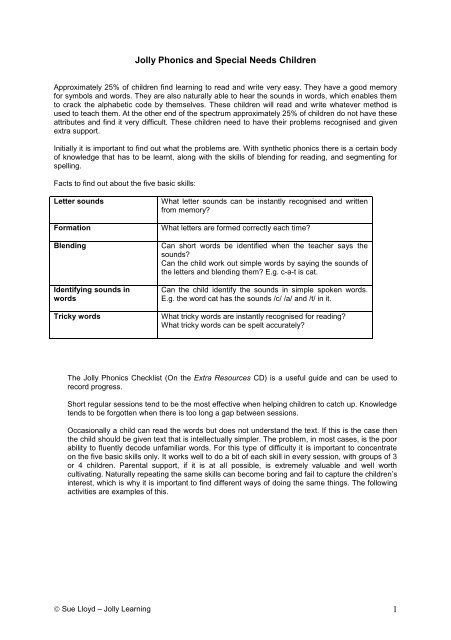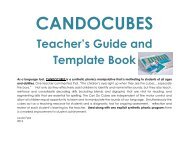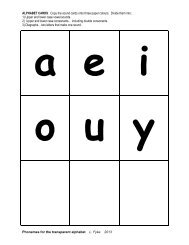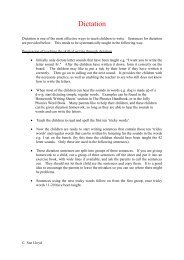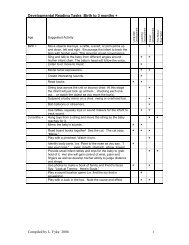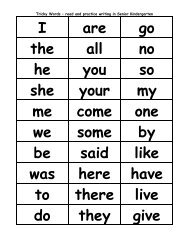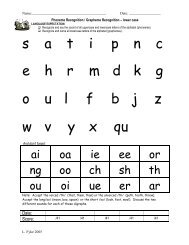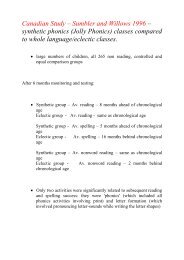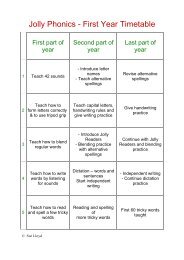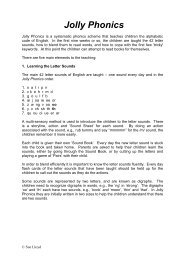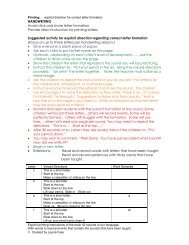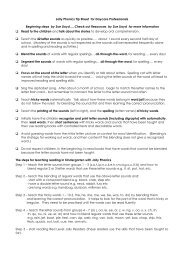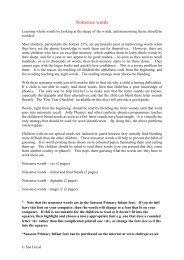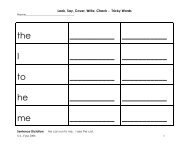Z- Special Needs and JP.pdf - Primarily Learning
Z- Special Needs and JP.pdf - Primarily Learning
Z- Special Needs and JP.pdf - Primarily Learning
Create successful ePaper yourself
Turn your PDF publications into a flip-book with our unique Google optimized e-Paper software.
Jolly Phonics <strong>and</strong> <strong>Special</strong> <strong>Needs</strong> Children<br />
Approximately 25% of children find learning to read <strong>and</strong> write very easy. They have a good memory<br />
for symbols <strong>and</strong> words. They are also naturally able to hear the sounds in words, which enables them<br />
to crack the alphabetic code by themselves. These children will read <strong>and</strong> write whatever method is<br />
used to teach them. At the other end of the spectrum approximately 25% of children do not have these<br />
attributes <strong>and</strong> find it very difficult. These children need to have their problems recognised <strong>and</strong> given<br />
extra support.<br />
Initially it is important to find out what the problems are. With synthetic phonics there is a certain body<br />
of knowledge that has to be learnt, along with the skills of blending for reading, <strong>and</strong> segmenting for<br />
spelling.<br />
Facts to find out about the five basic skills:<br />
Letter sounds<br />
Formation<br />
Blending<br />
Identifying sounds in<br />
words<br />
Tricky words<br />
What letter sounds can be instantly recognised <strong>and</strong> written<br />
from memory?<br />
What letters are formed correctly each time?<br />
Can short words be identified when the teacher says the<br />
sounds?<br />
Can the child work out simple words by saying the sounds of<br />
the letters <strong>and</strong> blending them? E.g. c-a-t is cat.<br />
Can the child identify the sounds in simple spoken words.<br />
E.g. the word cat has the sounds /c/ /a/ <strong>and</strong> /t/ in it.<br />
What tricky words are instantly recognised for reading?<br />
What tricky words can be spelt accurately?<br />
The Jolly Phonics Checklist (On the Extra Resources CD) is a useful guide <strong>and</strong> can be used to<br />
record progress.<br />
Short regular sessions tend to be the most effective when helping children to catch up. Knowledge<br />
tends to be forgotten when there is too long a gap between sessions.<br />
Occasionally a child can read the words but does not underst<strong>and</strong> the text. If this is the case then<br />
the child should be given text that is intellectually simpler. The problem, in most cases, is the poor<br />
ability to fluently decode unfamiliar words. For this type of difficulty it is important to concentrate<br />
on the five basic skills only. It works well to do a bit of each skill in every session, with groups of 3<br />
or 4 children. Parental support, if it is at all possible, is extremely valuable <strong>and</strong> well worth<br />
cultivating. Naturally repeating the same skills can become boring <strong>and</strong> fail to capture the children’s<br />
interest, which is why it is important to find different ways of doing the same things. The following<br />
activities are examples of this.<br />
Sue Lloyd – Jolly <strong>Learning</strong> 1
Letter Sounds<br />
<br />
<br />
<br />
<br />
<br />
Flash cards – revise with actions <strong>and</strong> without actions (avoid having too many that are totally<br />
unknown – build up gradually as you teach the unknown ones)<br />
Pouncing game – lay letter sound flash cards on table (face up) – call out a sound <strong>and</strong> see<br />
who can bang their h<strong>and</strong> on it first.<br />
Pass the letter sound – call out a letter sound <strong>and</strong> ask one child to give it to another in the<br />
group or to you.<br />
Pairs Game – lay the cards face down – as the child turns a card over he/she says the sound<br />
– if correct he/she keeps the pair <strong>and</strong> has another go (useful for reinforcing <strong>and</strong> developing<br />
fluency rather than learning. On the whole it is too time consuming for the intervention session<br />
but useful for homework with a parent, or in the classroom with a child who knows the letter<br />
sounds well).<br />
Snap – make sure each child has the same letter sounds in their pack – ask them to say the<br />
sound as they turn the letter over <strong>and</strong> then ‘Snap’ if the sounds are the same. The first to say<br />
‘Snap’ gets all the cards (similar to Pairs for reinforcing, <strong>and</strong> practising at a different time to<br />
the intervention session)<br />
Formation<br />
<br />
<br />
<br />
<br />
Air writing – children form letter in the air either by following the teacher’s example or in<br />
response to the letter being called out.<br />
Dictation of letter sounds - call out letter sounds for the children to write – check for correct<br />
formation (writing them <strong>and</strong> saying the sounds at the same time not only helps the children to<br />
write them it also helps them to recognise the letter sounds more fluently – both essential<br />
skills). The children can write on white boards, plain paper or paper with lines that guide <strong>and</strong><br />
develop correct proportion <strong>and</strong> neat h<strong>and</strong>writing (dependent on the age <strong>and</strong> dexterity of the<br />
child).<br />
S<strong>and</strong> writing – put s<strong>and</strong> on the shiny lid of a large biscuit tin – child forms letter with finger <strong>and</strong><br />
exposes the shiny surface (particularly for a child who keeps getting the formation wrong).<br />
Feel the shape – either use the cut out grooves in the Finger Phonics books or s<strong>and</strong>paper<br />
letters (Montessori idea)<br />
Blending – hearing the word when an adult says the sounds<br />
<br />
<br />
<br />
<br />
Which one is it? – put three simple cvc objects or pictures in front of the child(ren) e.g. book,<br />
hat, pen (cvc cards available from LDA!) Then say ‘Which one is the h-a-t? Gradually, after<br />
succeeding at this, increase the difficulty e.g. have more objects/pictures to choose from: hold<br />
card so child cannot see it <strong>and</strong> say the sounds – child says word <strong>and</strong> you turn the card round<br />
to show whether correct or not.<br />
Where in the picture? – pick out simple objects from the picture <strong>and</strong> say the sounds e.g. ‘Who<br />
can see the d-o-g?’<br />
Find on your body? – Where is your l-e-g? (ar-m, h-ea-d, f-oo-t, n-e-ck, h-a-n-d, t-oe-z, kn-ee<br />
etc.)<br />
My turn, your turn – have set of 10 (approx) short words – say sounds in each word <strong>and</strong> give<br />
answer e.g. m-a-n man (move pointed finger as you say each sound <strong>and</strong> your run finger along<br />
imaginary word when you say the word). Then children repeat what you have just modelled.<br />
The finger movements are to keep the children in unison.<br />
Sue Lloyd – Jolly <strong>Learning</strong> 2
Blending words<br />
Word Bank – prepare sets of words for blending e.g. cvc regular words that use the first 6<br />
letter sounds, cvc regular words that use the first 12 letter sounds etc., sets of regular words<br />
that have initial consonant blends, sets of words that have the /ai/ sound but are spelt with the<br />
3 alternative ways of writing them (‘ai’ words on green paper, ‘ay’ words on blue <strong>and</strong> ‘a-e’<br />
words on pink paper – different colours make it easier to keep organised) etc.<br />
<br />
<br />
<br />
<br />
Who gets it first? – hold up flash card of a regular word. The first one to read it gets it. Count<br />
up at the end to find out who the winner is.<br />
Consonant <strong>and</strong> short vowel blending (for children who are slow at blending, or who find it<br />
difficult to hear the word when they have said the sounds) – have plenty of cards with a<br />
consonant <strong>and</strong> a short vowel on them (see Jolly Extra Materials disk) – the child has to pick it<br />
up, blend it, <strong>and</strong> keep it if it is correct. The child with the most cards is the winner. When<br />
appropriate, progress to cards with consonant blends <strong>and</strong> short vowels, then digraphs <strong>and</strong><br />
short vowels <strong>and</strong> after that with long vowels.<br />
Cut the word – provide words for the children to cut up into their individual sounds (with<br />
scissors or pencil line) e.g. ‘bat’ bat, ‘spell’ spell, ‘train’ train, ‘supper’ supper,<br />
‘shadow’ shadow – making sure the digraphs have been taught, such as the /ow/ in<br />
shadow.<br />
Blending long words – as early as possible encourage the children to enjoy working out long<br />
words by blending the beginning of the words <strong>and</strong> then adding the other sounds from left to<br />
right, or seeing if they can get the word that you are writing before you have come to the end<br />
of writing it. Use words like ‘carpet, cobweb, magnet, carrot, bumpy, dustbin, chatterbox,<br />
popcorn, September etc.’<br />
Identifying the sounds in words<br />
<br />
<br />
<br />
<br />
<br />
Phoneme fingers – call out simple short words for the children to call out the sounds in the<br />
words – holding up a finger for each sound/phoneme.<br />
My turn, your turn - have a set of 10 (approx) short words – say the word <strong>and</strong> then say each<br />
sound e.g. leg… l-e-g (move h<strong>and</strong> in a vertical straight position along the imaginary word <strong>and</strong><br />
then go back <strong>and</strong> make a downward movement for each sound as you say it). Then the<br />
children repeat what you have just modelled by themselves. You use the h<strong>and</strong> movements to<br />
keep the children in unison.<br />
Building words – provide a card with three dashes on it <strong>and</strong> a set of letters e.g. h,o,t,i,p,n. Call<br />
out the word ‘hot’. The child or children have to think of the sounds in the word <strong>and</strong> pick up the<br />
letters for those sounds <strong>and</strong> lay them in the left to right order on the dashes. Another child<br />
could be asked to change the word from ‘hot’ to ‘hit’ – this continues with the words pit, pin,<br />
fin, fit <strong>and</strong> back to ‘hot’.<br />
Magnetic Letters or Letter Sound Board – vowels at the top of the board <strong>and</strong> some<br />
consonants at the bottom – simple words are called out for a child to build in the middle.<br />
Group Word Building – deal out letter sound cards – each child lays their cards in front of<br />
them <strong>and</strong>, in turn, identifies the letter sounds they were given. The teacher calls out a word<br />
<strong>and</strong> the child who has the letter or digraph for the first sound lays it in the middle, then the<br />
child with letter or digraph for the second sound puts it next to the first – continue until the<br />
word is completed.<br />
Sue Lloyd – Jolly <strong>Learning</strong> 3
Dictation – call out sounds for the children to write the letters for those sounds (close<br />
together), such as d o g (as extra interest use sounds that make a word) <strong>and</strong> see which child<br />
is the fastest at working out the word).<br />
Word Dictation – call out words for the children to write.<br />
Sentence Dictation – call out sentences for the children to write. The sentences should consist<br />
of regular words that can be written by listening for the sounds <strong>and</strong> tricky words that have<br />
been taught.<br />
Tricky Words – for reading<br />
<br />
<br />
<br />
<br />
<strong>Learning</strong> Correct Pronunciation – sound out (blend) unknown tricky words <strong>and</strong> then teach the<br />
correct pronunciation e.g. w-a-s when blended gives ‘was’ (rhymes with mass) <strong>and</strong> the real<br />
pronunciation is ‘was’ (woz). After that give plenty of practice.<br />
Say Correct Pronunciation – the teacher says the tricky word as it should be pronounced e.g.<br />
‘was’ (to rhyme with mass) <strong>and</strong> the children chant the proper word ‘was’ (woz).<br />
Flash Cards – quickly hold up the cards <strong>and</strong> revise the words that have been taught. Put the<br />
fairly well known tricky words in a box/envelope <strong>and</strong> send home for revision. The aim is to<br />
improve fluency at saying the words.<br />
Pouncing Game – play in the same way as the Letter Sound Pouncing Game – except use<br />
tricky words instead of letter sound cards. Alternatively write tricky words on pieces of paper<br />
<strong>and</strong> space them out on the floor. The first child to jump on the correct word, after the teacher<br />
has called it out, gets a point. The child with the most points is the winner.<br />
Tricky Words – for spelling<br />
(three techniques for teaching spelling are given in the Phonics H<strong>and</strong>book)<br />
<br />
<br />
Dictation – call out the tricky words that you have been working on for the children to write.<br />
Build Tricky Words – provide the necessary letter sounds on the table. Call out tricky words for<br />
the children to make with the letters.<br />
Good synthetic phonics programmes use the above five basic skills. It is important to underst<strong>and</strong> the<br />
sequence for introducing these skills <strong>and</strong> to make sure that the children are taught in a step-by-step<br />
progression. They should not be asked to do something that has not be taught, such as read words<br />
that have digraphs that have not been introduced. Care should be taken to keep it as simple as<br />
possible <strong>and</strong> to ensure that the children are succeeding at every stage. It is important not to stay too<br />
long with any activity <strong>and</strong> to keep an element of fun about it all.<br />
Sue Lloyd – Jolly <strong>Learning</strong> 4


